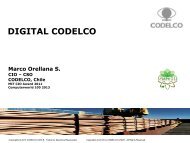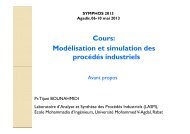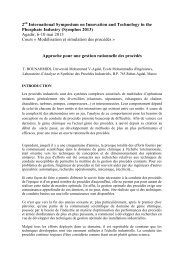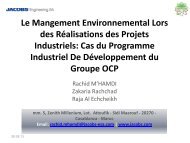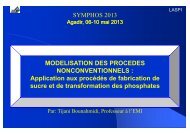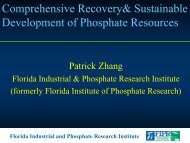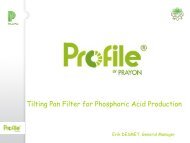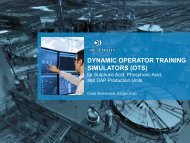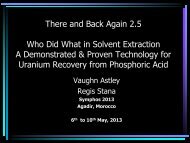Abstract SYMPHOS 2011
Abstract SYMPHOS 2011
Abstract SYMPHOS 2011
You also want an ePaper? Increase the reach of your titles
YUMPU automatically turns print PDFs into web optimized ePapers that Google loves.
100<br />
MANUFACTURE OF HIGH-BULK DENSITY ALUMINIUM FLUORIDE FROM<br />
FLUOSILICIC ACID<br />
Alain Dreveton,<br />
AD Process Strategies Sarl, Rue Chaponnière 9, CH-1201<br />
Geneva / SWITZERLAND<br />
AP-O-12<br />
Fuosilicic acid finds its main application in the manufacture of aluminium fluoride being a large volume chemical<br />
mostly produced from fluorspar as high bulk density (HBD) aluminium fluoride and as well from fluosilicic acid<br />
as low bulk density (LBD) aluminium fluoride. Hereby is disclosed new processes for manufacturing anhydrous<br />
hydrofluoric acid (AHF) from fluosilicic acid (FSA) from which (HBD) aluminium fluoride can be produced. Aluminium<br />
fluoride is essentially used as a flux for smelting aluminium by adding it volumetrically to the cells of aluminium<br />
smelters in order to regenerate the cryolite bath. HBD aluminium fluoride is the preferred material and it is fully<br />
produced from fluorspar; none of this material being currently produced from FSA through AHF which process<br />
technology often referred to as the Dry/FSA Process is available, feasible and proven at this time. An opportunity<br />
to invest in profitable projects is really existing. Additionally the manufacture of other downstream products of HF:<br />
refrigerants, fluoropolymers, etc and downstream products of FSA: silicon metal, silicon tetrafluoride, silicas may<br />
offer extra opportunities.<br />
The first process known for manufacturing (LBD) aluminium fluoride from fluosilicic acid was patented by Chemie-<br />
Linz, Austria and many plants were built based on this technology or similar technologies. This process uses the<br />
direct neutralization of the fluosilicic acid with alumina hydroxide in a stirred reactor. It is often referred to as<br />
the Wet/FSA Process. Although this technology tends to be abandoned due to the low density and low fluidity<br />
(flowability) of the product, the high capital cost of the plant and environmental issues resolved partially only<br />
as neutralization of mother liquors may still be required, further developments of this process would refresh this<br />
technology being still accepted by very few players only.<br />
A process to produce AHF / HF from fluosilicic acid was disclosed first by Tennessee Corp., USA and<br />
further by Wellmann-Lord, etc and more lately by Flemmert (Sweden), and Lubon Works, Poland who operated a<br />
small pilot plant. More recently Wengfu, China built a first commercial plant with the technology of Buss Chemtech<br />
AG, Switzerland based on know-how from Lubon Works. The process is based on the mixing of strong fluosilicic<br />
acid with strong sulphuric in a stirred reactor and separating silicon tetrafluoride and extracting the anhydrous<br />
hydrofluoric acid using separation columns. Presently AD Process Strategies Sarl proposes a similar type of<br />
process with major improvements completed to suit the water balance of the phosphoric acid plant; sulphuric<br />
acid containing water that is generated from this HF plant has to be recirculated to the phosphoric acid plant. The<br />
technology is proven, resolves environmental issues, is very profitable as raw material costs are low, capital cost is<br />
reasonable and it offers access to promising markets for HBD aluminium fluoride and anhydrous hydrofluoric acid,<br />
both being large volume chemicals.<br />
For situations described above when the diluted sulphuric acid stream is not returned to the phosphoric<br />
acid plant or can not be recirculated due to technically reasons or not, AD Process Strategies Sarl proposes a new<br />
technology for stand alone HF plants. The proposed process uses fluosilicate as intermediate raw material, which is<br />
transportable not like FSA and reaction of fluosilicate with sulphuric acid. The silicon tetrafluoride and hydrofluoric<br />
acid obtained is treated as per the state of art mentioned above. The diluted sulphuric acid stream from this process<br />
can be preconcentrated and recycled to the phosphoric acid plant or used in production of fertilizers, concentrated<br />
and recycled to the HF reaction or purified and sold.<br />
These technologies are offering high flexibility and can be implemented with confidence in a cost effective manner.<br />
They are real innovations for the fertilizer industry and surely they will be implemented progressively. More and<br />
more projects are under study and hopefully some projects may be executed in the near future….



